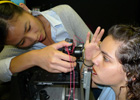|
|
 |

|
 |
 |
| |
 |
|
Robust Human-Systems Interfaces
Earth-bound human performance generally must overcome a constant downward gravitational load (+1 Gz), whereas astronauts are required to perform under a wide range of altered and challenging gravitational loads into the chest both static (up to ~4 Gx) and during dynamic (up to ~0.5 Gx) vibration. In particular, during the high-Gx plus vibration conditions of launch, the crew will need to monitor displays, requiring accurate target localization and gaze stabilization/control, and may be called upon to reach towards and throw switches requiring, in addition, accurate motor control of the hand and arm within the altered force field. Using the 20-g centrifuge and vibration facilities at Ames, we quantified the effects of sustained (+1 or +3.8 Gx) and dynamic (±0.5 Gx at 8, 12, or 16 Hz) gravitational loads (in isolation and combination) on human sensorimotor control in order to dissect the vestibular, visual, and motor limitations on human performance.
|
| |
|
 |
Oculometrics
Voluntary eye movements provide a model system to investigate the links between action, perception, and cognition because the visual stimuli can be carefully crafted and controlled, and the motor action can be easily and precisely quantified (e.g., Stone et al., 2009). Two types of voluntary eye movements, saccades and smooth pursuit, are guided using sensorimotor signals from a network of cortical and subcortical structures, having extensive reciprocal connections with a number of visual cortical areas. Using eye-movement choices as a model system, we test questions about the types of signals (i.e., decision variables, top-down modulations, internal noise) that contribute to both perception and oculomotor choice behavior. |
| |
|
|
|
|